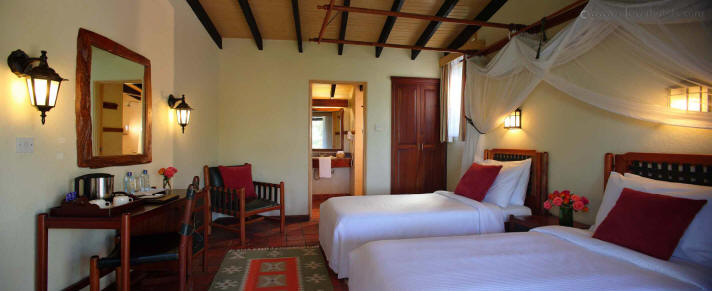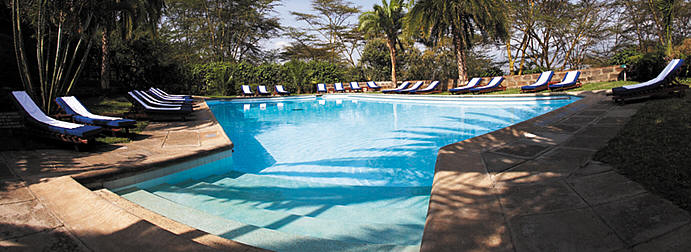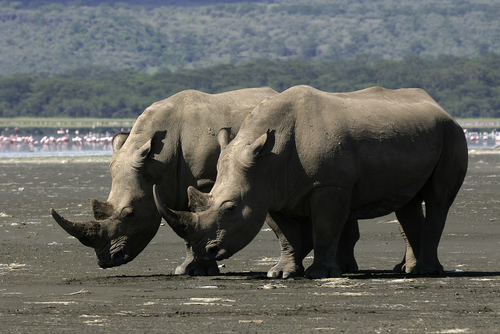|
Lake Nakuru National Park
or Game Park
is an ornithological paradise located two hours drive, 156
Kilometers west of Nairobi on the floor of Rift valley. The
park dates back to 1961 when the southern park of the lake was gazetted as a bird to protect the "greatest
bird (ornithological) spectacle on earth", for the future
generations. In 1964, the whole of the lake was declared a
bird sanctuary. in 1968, the
Lake Nakuru
shores were added into the sanctuary and
the whole area was upgraded to a National Park. In 1974 a northern extension
was added to the park increasing its area to the
current 188 Km2. In 1990
Lake Nakuru Game Park
is a
designated a Ramsar site- for protection
of an important international wetland.
Accommodation in Lake Nakuru National is diverse to cater for
different categories of visitors. Visitors have a choice of
either sleeping inside the park or outside the park. Inside
the park, there are two safari lodges, one tented camp, a private
house , Kws bandas and public campsites. The two
safari lodges in the park are Lake Nakuru Lodge and Lion Hill Lodge.
The two facilities offer mid range to luxury accommodation to their
guests. The only truly mid range property in the park is the
Flamingo Hills Tented Camp. Kws bandas and campsites offer
budget alternatives to locals and tourists alike. Nakuru town has
both mid range and budget hotels to cater for visitors.
Lake Nakuru Lodge (Single USD 200, Double USD 300, Junior Suite
Double USD 400, Senior Suite Double USD 550)

Located inside the park.
The lodge caters for 180 guests. Room categories include
family rooms, deluxe cottages, or suites. From Nairobi
visitors can either drive to the lodges (2 Hrs) or take a 25 minutes
flight. The lodge enjoys and ideal location with spectacular
views of the lake shores and the park in general. Below is the
swimming pool of Lake Nakuru lodge.

Lion
Hill Game Lodge

Above is a twin room at
Lion Hill Lodge and below swimming pool.
Located 2 hours drive or
25 minutes flight from Nairobi, Lion Hill is nestled along the Lion
Hill overlooking the spectacular flamingo pink rimmed Lake Nakuru.
The location affords panoramic views of the Lake and the picturesque
Lake Nakuru National Park. The Lodge is a favorite with residents
and visitors to Kenya. All chalet style rooms and suites at Sarova
Lion Hill Game Lodge have:
Private patios with panoramic views of the flamingo pink rimmed Lake
Nakuru, en-suite bathrooms with permanent showers and WC, running
hot & cold water, razor outlets with 220 and 240 volts, beds with
mosquito nets and duvets 240V power 24 hours.
The lodge has 2 conference
rooms available. Conference equipments (Overhead projectors,
LCD Projector, w/screen, TV and Video, flip chart board, writing
pads, markers and pens.) Capacity 45 U-shaped style, 100 Cocktail
style and 70 Theatre style
Free use of designated areas for breakaways.
Children are welcome at
Lion Hill Game Lodge. The Lodge has a special Activity Room for
children, well stocked with games such as archery, darts, table
tennis, carom board, movies and activities for children. Children
also enjoy activities such as swimming, walking safaris and
bird-watching within the secure premises. We have specially trained
staff who escort the children and facilitate activities for
children. They also enjoy viewing the lake and the park through the
powerful telescope located near the amphitheatre.

Tented Camps
Flamingo Hill Tented Camp, There are 25 en-suite tents with WC and flush toilets,
writing desk, hot water and a balcony. They also have
conference and laundry facilities.
Hotels And Guest Houses in Nakuru Town
Nakuru town is served by
several and guest houses hotels to
cater for all classes of travellers ranging from Budget, to mid range
properties. These include, Midland Hotel, Hotel Genevieve, Pivot Hotel, Eros Guest House, Stem Hotel,
Bandas in Lake Nakuru:
Naishi banda; Rhino banda; Chui banda; Reedbuck banda; KWS Isikon
banda; Nyuki banda; Soysambu banda; Makalia Falls banda; KWS Guest
House; WCK Education Centre & KWS Education Centre bandas.
Lake Nakuru National
Park Safaris
Lake Nakuru National
Park is a premier tourism destination attracting diverse
visitors of different backgrounds and with differing interests. It
is the best place to see flamingoes, leopards and rhinos.
Nature lovers from all over the world congregate in the park for
relaxation and adventure. With over 450 species of birds
identified, the home of flamingoes is an undisputed ornithological
Paradise. A two nights stay will give you enough time to enjoy
the numerous activities on offer-game drives, bird watching, nature
walks. The greatest crowd puller is the annual Cycle With The
Rhino Festival.
Lake Nakuru can be visited
within a day from Nairobi(See 1 day Lake Nakuru Excursion, 2 Days 1
Night Lake Nakuru Safari) . A combination of safaris enables
one to visit both lake Nakuru and Maasai Mara National Parks (see
Nairobi Lake Nakuru Naivasha Maasai Mara 4 days 3 nights.)
Other combinations feature
nearby attractions-Mt Kenya, Sweet Waters, Menengai Crater, Hells'
Gate, Lakes Naivasha, Baringo and Bogoria. (See
Nairobi -Mt. Kenya-Samburu -Sweet Waters-Lake Nakuru-Maasai Mara 9
days safari)
|

Rare Rhinos
easily spotted in Lake Nakuru Park |
The
Park
is famous for its bird spectacle featuring over a million
flamingos, over 400 migratory bird species from around the world
and large flotillas of pelicans.
Two species of flamingoes exists in the lake Nakuru Game Park-
the lesser flamingo with deep red carmine bill and the greater
flamingo with black tip. The flamingos feed on Blue green algae,
created from their droppings mixing in the warm alkaline waters, and
planktons.
-
450 species
of birds ,56
different species of mammals, the rhino sanctuary.
-
View-points: and
hills
Lion hill, Baboon cliff and Out of Africa provide vintage views
-
Events- The
annual Cycle with the Rhino, Animal Count,
-
Waterfalls:
Makalia
-
Unique vegetation:
About 550 different plant species and The largest Euphorbia cnadlebrum forest in Africa, Picturesque landscape
and yellow acacia woodland.
-
Bahrain springs,
the only permanent water source of Lake Nakuru Park.
-
Rivers Makhalia and
Nderit are dry most of the time due to deforestation in Mau.
-
Reptiles:
A large number of reptiles inhabits the parks including
the python and tortoise.
-
The spectacular
scenery of the Rift-valley.
Lake Nakuru Rhino
Sanctuary:- The Rhino Sanctuary was established
1984. In 1986 a solar powered electric was
installed by Rhino Rescue Trust. The Rhino Sanctuary began with the
translocation of two adult males, one from Kitengala and the
other from Lewa Downs.
Today the rhino population stands at 60 Black Rhinos and 40
White Rhinos. The main challenges of lake Nakuru as a
conservation site are a large population, deforestation of the
catchments, siltation and pollution.
Other Activities in
Lake Nakuru National Park-What see and do:
Besides game drives
and visits to the Rhino Sanctuary, other activities include bird
watching, event participation, picnics, and visitis to
Hyrax hill archeological site, Menengai crater and the nearby
lakes Bariong and Bogoria.
Picnic sites in the park:
Makalia Falls, Enjoro River Mouth near the main gate, Baharini,
Acacia, Baboon Cliff, Out of Africa, Lion Hill Summit.
Lake Nakuru park gates: Main Gate, Lanet and
Nderit.
Conservation Status:
The main challenges of existence of Lake Nakuru Park as a
bird spectacle are threefold-the pollution of the lake from domestic
and industrial wastes from Nakuru town, the decreasing level of the
lake and the large mammal population which tends to interfere with
the lakeshore breeding grounds of birds. In addition to these
two is the fact that the park is completely fenced hence animals
cannot freely migrate in and out of the sanctuary. Equally
significance is the absence of the elephants which has resulted in
some parts of the being heavily forested and hence not ideal for
game watching.
A major threat to the existence of Lake Nakuru National Park is
the drying up of rivers due to recent incursions into Mau Forest.
Unless urgent measures are taken to re afforest Mau, Lake Nakuru,
Maasai Mara and even Serengeti ecosystems will never be the same.
|